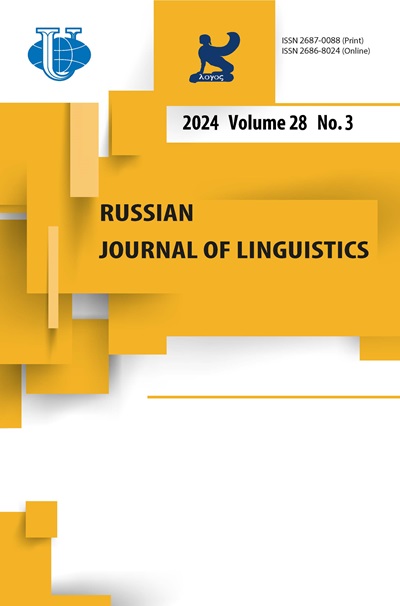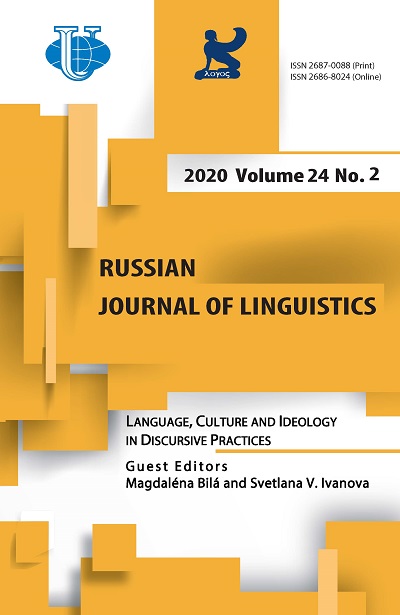Политический дискурс, переключение кода и идеология
- Авторы: Муди С.1, Еслами З.Р.1,2
-
Учреждения:
- Техасский университет A & M
- Техасский университет A & M в Катаре
- Выпуск: Том 24, № 2 (2020): Язык, культура и идеология в дискурсивных практиках
- Страницы: 325-343
- Раздел: Статьи
- URL: https://journals.rudn.ru/linguistics/article/view/24096
- DOI: https://doi.org/10.22363/2687-0088-2020-24-2-325-343
Цитировать
Полный текст
Аннотация
Язык и идеология - это область критического дискурс-анализа, которая привлекает все большее внимание лингвистов. Возрастание влияния средств массовой информации обусловило необходимость анализа языковых механизмов, особенно в политическом дискурсе. Переключение кода между двумя и более языками или диалектами в соответствии с определенными экстралингвистическими факторами (Blom & Gumperz 1972) является стратегией политиков, используемой для получения поддержки на выборах (Jarraya 2013; Craig 2013). Сенатор Тим Кейн был одним из первых белых политиков, применивших переключение кода во время президентских выборов 2016 года. Однако использование им испанского языка в политических выступлениях вызвало неодобрением и скептицизмом у средств массовой информации и избирателей, многие из которых посчитали, что он заигрывает перед испаноязычным населением. Цель данной статьи - определить, как переключение кода использовалось сенатором Кейном в качестве инструмента политического дискурса и как оно варьировало в зависимости от контекста каждого выступления. Чтобы ответить на эти вопросы, мы проанализировали четыре речи сенатора Кейна во время президентской кампании 2016 года, которые были предварительно застенографированы и переведены. Применяя метод описательного кодирования (Saldaña 2015), два эксперта выделили случаи переключения кода в каждой речи для выделения ключевых характеристик политического дискурса: а) распространение личной информации или фактов жизни; б) повторы; в) гипербола; г) метафора; д) метонимия; е) сравнения; ж) обещания на будущее; з) солидарность; и) легитимация себя как власти; к) витиеватое многословие. Результаты показали, что сенатор Кейн больше всего полагался на переключение кода и использовал его в качестве тактики, чтобы заручиться поддержкой аудитории и выстроить доверительные с ней отношения, во время своего выступления в Майами, штате Флорида. Кроме того, через переключение кода сенатор Кейн многократно делал повторы, чтобы выделить ключевые моменты своей речи и свои политические цели. Проведенное исследование показало, как переключение кода может использоваться в целях получения политического преимущества, создания альянсов и демонстрации культурных сходств между белыми политиками и двуи многоязычными избирателями.
Ключевые слова
Об авторах
Стефани Муди
Техасский университет A & M
Автор, ответственный за переписку.
Email: smmoody@tamu.edu
has over a decade of experience teaching elementary ESL, and is currently a Ph.D. candidate
Колледж-Стейшен, СШАЗохрэ Р. Еслами
Техасский университет A & M; Техасский университет A & M в Катаре
Email: zeslami@tamu.edu
профессор кафедры педагогической психологии
Колледж-Стейшен, США; Доха, КатарСписок литературы
- Blom, Jan-Petter, John Gumperz & Dell Hymes. 1972. Directions in sociolinguistics. 407-434
- Bwenge, Charles. 2009. Linguistic identity and (re)construction in electoral politics: The case of 2005 Tanzanian parliamentary campaigns. In Koen Bostoen, Akinloye Ojo & Lioba Moshi (eds.), Selected proceedings of the 39th annual conference on African linguistics, 166-178. Cascadilla Proceedings Project
- Chilton, Paul. 2004. Analysing Political Discourse: Theory and Practice. London, UK: Routledge.
- Chouliaraki, Lilie. 2005. Introduction: The soft power of war: Legitimacy and community in Iraq war discourses. Journal of Language and Politics 4(1). 1-10.
- Corner, John. 2003. Mediated personal and political culture. Media and the Restyling of Politics. 67-84.
- Craig, Geoffrey. 2013. How does a Prime Minister speak?: Kevin Rudd’s discourse, habitus, and negotiation of the journalistic and political fields. Journal of Language and Politics 12 (4). 485-507.
- Davletbaeva, Diana N., Marianna E. Yashina & Alina D. Sharafieva. 2016. Linguistic peculiarities of the modern political discourse of Russia and the USA. Journal of Organizational Culture, Communication, and Conflict 20. 242-247.
- Fairclough, Norman. 1995. Critical Discourse Analysis. Longman.
- Hague, Rod, Martin Harrop & Shaun Breslin. 1998. Comparative Government and Politics: An Introduction. 4th edn. Palgrave Macmillan.
- Hay, Colin. 2013. Political discourse analysis: The dangers of methodological absolutism. Political Studies Review 11 (3). 321-327
- Jarraya, Soufien. 2013. Persuasion in political discourse: Tunisian President Ben Ali's last speech as a Case Study
- Johnson, Kevin R. & Bernard Trujillo. 2011. Immigration Law and the US-Mexico Border: ¿Sí Se Puede?. University of Arizona Press
- Kementchedjhieva, Yova. 2016. Code-switching as strategically employed in political discourse. Lifespans and Styles 2 (1). 3-9
- Krogstad, Jens Manuel, Jeffrey S. Passel & D’Vera Cohn. 2019. 5 facts about illegal immigration in the U.S. Pew Research Center. [Electronic resource]. URL:https://www.pewresearch.org/fact-tank/2019/06/12/5-facts-about-illegal-immigration-inthe-u-s/
- Lipka, Michael. 2015. A closer look at Catholic America. Pew Research Center. [Electronic resource]. URL: http://www.pewresearch.org/fact-tank/2015/09/14/a-closer-look-atcatholic-america/
- McCann, James A., & Katsuo A. Nishikawa Chavez. 2016. Partisanship by invitation: Immigrants respond to political campaigns. The Journal of Politics 78 (4). 1196-1210
- Medina, Brenda. 2018. Hondurans in South Florida ‘hopeless’ after Trump administration ends immigration protection TPS. Miami Herald. [Electronic resource]. URL: https://www.miamiherald.com/news/local/article210523599.html
- Mirzaei, Azizullah, Zohreh. R. Eslami & Fatemeh Safari. 2017. Exploring RhetoricalDiscursive Practices of Rouhani’s Presidential Campaign and Victory of his Prudenceand-Hope Key: A Discourse of Persuasion. Russian Journal of Linguistics. Special issue Discourse Analysis in the 21st Century: theory and practice 27 (1). 161-182
- Ponton, Douglas, M. 2016. Movements and Meanings towards an Integrated Approach to Political Discourse Analysis. Russian Journal of Linguistics 20 (4). 122-139
- Newman, Benjamin J., Sono Shah & Loren Collingwood. 2018. Race, place, and building a base: Latino population growth and the nascent Trump campaign for president. Public Opinion Quarterly 82 (1). 122-134
- Noe-Bustamante, Luis, Antonio Flores & Sono Shah. 2019. Facts on Latinxs of Honduran origin in the United States, 2017. Pew Research Center. [Electronic resource]. URL: https://www.pewresearch.org/Latinx/fact-sheet/u-s-Latinxs-facts-on-honduran-originlatinos/
- Obeng, Samuel Gyasi. 1997. Language and politics: Indirectness in political discourse. Discourse & Society 8 (1). 49-83
- Opeibi, Tunde Olusola. 2007. One message, many tongues: An exploration of media multilingualism in Nigerian political discourse. Journal of Language and Politics 6 (2). 223-248
- Quam, Justin & Marianna Ryshina-Pankova. 2016. “Let me tell you…” Audience Engagement Strategies in the Campaign Speeches of Trump Clinton, and Sanders. Russian Journal of Linguistics 20 (4). 140-160
- Reyes, Antonio. 2015. Building intimacy through linguistic choices, text structure, and voices in political discourse. Language & Communication 43. 58-71
- Robinson, R. 2016. Top ten demographic trends in Austin, Texas. Austintexas.gov Saldaña, Johnny. 2015. The Coding Manual for Qualitative Researchers. Sage Publishing.
- Scotton, Carol Myers & William Ury. 1977. Bilingual strategies: The social functions of codeswitching. International Journal of the Sociology of Language 13. 5-20.
- Uzum, Baburhan & Melike Uzum. 2010. The historical and linguistic analysis of Turkish politician's’ speech. International Journal of Politics, Culture, and Society 23 (4). 213-224.
- van Dijk, Teun A. 2006a. Discourse and manipulation. Discourse & Society 17 (2). 359-383
- van Dijk, Teun A. 2006b. Politics, ideology, and discourse. Encyclopedia of Language & Linguistics. [Electronic resource]. URL: https://doi.org/10.1016/b0-08-044854-2/00722-7
- van Dijk, Teun A. 1998. Ideology: A Multidisciplinary Approach. SAGE
- van Dijk, Teun A. 1997. What is political discourse analysis? Belgian Journal of Linguistics 11 (1). 11-52
- van Dijk, Teun A. 1993. Principles of critical discourse analysis. Discourse & Society 4 (2). 249-283
- Wei, Jennifer M.Y. 2003. Codeswitching in campaigning discourse: The case of Taiwanese president Chen Shui-bian. Language and Linguistics 4 (1). 139-165
- Weiss, Gilbert, & Ruth Wodak. 2003. Introduction: Theory, interdisciplinarity and critical discourse analysis. In Gilbert Weiss & Ruth Wodak (eds.), Critical Discourse Analysis: Theory and Interdisciplinarity, 1-34. Hampshire: Palgrave MacMillan
- Wodak, Ruth. 2009. Language and politics. In Jonathan Culpeper, Paul Kerswill, Ruth Wodak, Tony McEnery & Francis Katamba (eds.), English Language: Description, Variation and Context, 576-593. Palgrave Macmillan
- Wodak, Ruth. 2004. Preface: The power of language in political discourse. Journal of Language and Politics 3 (3). 381-383
- Young, Vershawn Ashanti. 2009. "Nah, we straight": An argument against code switching. JAC. 49-76
- ABC15 Arizona. 2016, July 27. Full Tim Kaine acceptance speech 2016 Democratic National Convention. YouTube. https://youtu.be/w1scCwsnwIs
- Grossmand, Les. 2016, July 23. Tim Kaine full speech in English and Spanish in Miami. YouTube. https://youtu.be/rR0j7Xt8ez4
- Grossmand, Les. 2016, July 23. Tim Kaine full speech in English and Spanish in Miami. YouTube. https://youtu.be/rR0j7Xt8ez4
- Kaine, Tim. 2016, August 9. Full speech: Tim Kaine speech in Austin, Texas. YouTube. https://youtu.be/LfMltcKO43c
- Kaine, Tim. 2016, August 30. Tim Kaine speech in Lancaster, PA. YouTube. https://youtu.be/hfdyYTlhogs
- Office of Immigration Statistics. 2013. Immigration data and statistics. Department of Homeland Security. https://www.dhs.gov/data-statistics
- S. Census Bureau. 2015. Quick facts: Miami-Dade County, Florida. http://www.census.gov/ quickfacts/table/RHI725215/12086
- S. Census Bureau. 2016. Newsroom: Facts for features. http://www.census.gov/ newsroom/facts-for-features/2016/cb16-ff16.html

















